Partner violence in people with gender dysphoria
DOI:
https://doi.org/10.22235/cp.v13i2.1871Keywords:
intimate partner violence, transgender, gender dysphoria, resources, empirical studyAbstract
The first objective of the research was to know and evaluate the types of partner violence in a 48 persons with gender dysphoria group; and, secondly, to establish differences based on identity. An adaption of the survey by Díaz y Núñez (2015) was used. The highest percentage of violence experienced occured in psychological violence, followed by sexual and physical violence and, finally and to a lesser extent, economic violence. According to their identity, people with female identity suffered more physical, economic, sexual and psychological violence. In most people with a female identity who asked for help, violence was maintained or increased, while in those with masculine identity it ceased o remained. People with a female identity suffer more partner violence in all its forms. The consequences of asking for outside help are also more negative for them.
Downloads
References
Dank, M., Lachman, P., Zweig, JM y Yahner, J.(2014). Dating Violence Experiences of Lesbian, Gay, Bisexual, and Transgender Youth. Journal of Youth Adolescence, 43, 846.
Díaz, J. y Núñez, J. (2015). Violencia al interior de parejas de la diversidad sexual (LGBTI). Liminales. Escritos sobre psicología y sociedad, 1(7), 43-63.
González Galbán, H. y Fernández de Juan, T. (2010). Género y maltrato: violencia de pareja en los jóvenes de Baja California. Estudios fronterizos,11(22), 97-128.
Hirigoyen, M. (2006). Mujeres maltratadas: los mecanismos de la violencia en la pareja. Buenos Aires: Paidós.
Langenderfer-Magruder, L., Walls, N.E., Whitfield, DL., Brown, SM, Barrett, CM. (2016). Partner Violence Victimization Among Lesbian, Gay, Bisexual, Transgender, and Queer Youth: Associations Among Risk Factors. Child Adolescence Social Work, 33(1), 55-68.
Langenderfer-Magruder, L., Whitfiel, D., Walls, E., Kattari, S. y Ramos, D. (2016). Experiences of Intimate Partner Violence and Subsequent Police Reporting Among Lesbian, Gay, Bisexual,Transgender, and Queer Adults in Colorado: Comparing Rates of Cisgender and Transgender Victimization. Journal of Interpersonal Violence, 31(5),855-71.
Organización Panamericana de la Salud-OPS. (2013). Comprender y abordar la violencia contra las mujeres. Violencia infligida por la pareja. Washington, DC: OPS.
Ristock, J. (2005). Relationship Violence in Lesbian/Gay/ Bisexual/Transgender/Queer [LGBTQ] Communities. Moving Beyond a Gender-Based Framework. Violence Against Women Online Resources.
Rodríguez, LM., Carrera, M., Lameiras, M. y Rodríguez, Y. (2015). Violencia en parejas transexuales, transgénero e intersexuales: una revisión bibliográfica. Saúde Soc. São Paulo, 24(3,) 914-935.
Roch, A., Ritchie, G., LGTB Youth Scotland, Morton, J. (2010). Out of sight, out of mind - Transgender People's Experiences of Domestic Abuse. Equality Network.
Turell, S. (2000). A Descriptive Analysis of Same-Sex Relationship Violence for a Diverse Sample. Journal of Family Violence, 15(3), 281–293.
Waters, E. (2016). Lesbian, Gay, Bisexual, Transgender, Queer, and HIV-Affected Intimate Partner Violence in 2015 A report from the National Coalition of Anti Violence Programs. Release Edition National Coalition of Anti-Violence Programs (NCAVP).
















